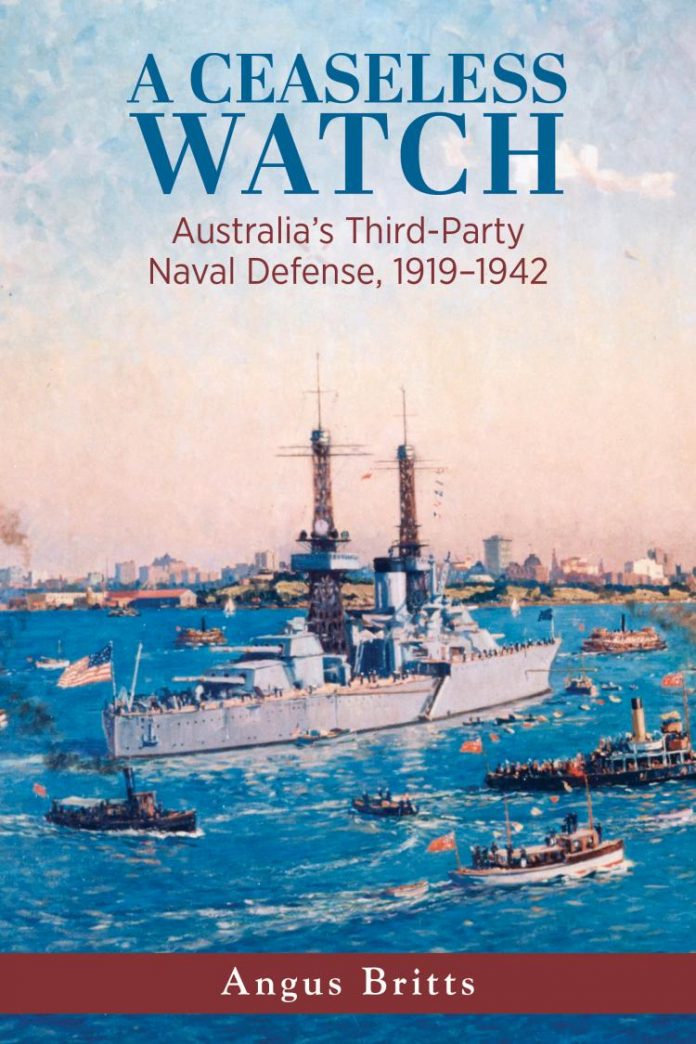
A Ceaseless Watch; Australia’s Third-Party Naval Defense, 1919-1942. By Angus Britts. Naval Institute Press, Annapolis, 2021.
Reviewed by Tim Coyle
‘Remember that day and night a ceaseless watch goes on all over the world, and keeps Australia just as safe and secure from all the Powers of the world as if every sailor and every British battleship belonged to you’.
In characteristic Edwardian prose, Australian prime minister George Reid reassured the crowd at the inaugural Empire Day address in 1905 at Tamworth, New South Wales, that Australia was protected by the might of the peerless Royal Navy.
As a Dominion of the greatest empire the world had seen, Australia had existed as a federated nation only since 1 January 1901 and while Australians considered themselves British, Reid’s assurances of British naval protection was not entirely shared by many of his countrymen; doubts which began in the early 19th century.
The enormous, but sparsely populated, island continent comprised six colonies, which became states of the federated Commonwealth of Australia. Foremost in the minds of strategically focussed citizens were threats of maritime attack by a range of perceived enemies. The French, Russians, Americans and Germans were all viewed, in varying degrees, as potential threats in the 19th century against which sophisticated artillery harbour defences were established in the colonial capitals. Maritime defence was a matter for the Royal Navy’s Australia Station, which most defence-minded Australians considered to be inadequate until October 1913 when the Royal Navy ships were relieved by the arrival of the new Royal Australian Navy Fleet Unit led by the battlecruiser HMAS Australia. But it was the rise of the Imperial Japanese Navy in the 1890s and early 1900s that alarmed the Australians, not least being the Anglo-Japanese naval treaty. It was these concerns that led to Australia seeking its own navy.
Ceaseless Watch is the story of Australian maritime defence from ‘Foundations: 1788-1918’ through to January 1943. The book examines Australian defence policy and political manoeuvrings to plead Australia’s case for adequate naval defence before the home government. This is a constant theme throughout the book – Australia’s interests being largely subsumed by the wider Admiralty strategic priorities and stretched resources. The central theme is, of course, the Singapore strategy which, touted by Britain as a vanguard against the Japanese Navy, was to defend Australia from the bastion of the Singapore naval base from which a Royal Navy battle fleet would sortie. The Singapore base was built, and the Royal Navy did sortie a battle fleet, but the two capital ships were destroyed by Japanese air power two days after the Pearl Harbor attack.
The immediate result of the sinking of Prince of Wales and Repulse, the Pearl Harbor attack and the Japanese invasion of Malaya stands with the 1915 ANZAC landing as pivotal in Australian military, political and social history. Ceaseless Watch leads inexorably to the stark realisation that Australia stood alone in December 1941. The book embeds Australian political history and defence policy into the interwar period. It discusses the Versailles Treaty negotiations with the combative Australian prime minister William Morris Hughes battling the allies, in particular browbeating US president Woodrow Wilson, to secure Australian mandates over Pacific islands as reparations for the huge toll of Australian troops in World War One. The narrative continues through the relative calm of the 1920s, the 1930s depression, which saw Australian defence capability reduced to virtual impotence, and the rising tensions of the late 1930s with Germany and Japan. Inherent Australian racism based on the White Australia Policy (the first Act passed by the new Federal Parliament in 1901) targeted Japan, virtually from that time, as the primary threat to Australia which festered in the inter-war period.
Australian prime minister John Curtin’s 27 December 1941 ‘look to America’ speech was the first step away from British historic influence over Australian strategic defence and the speech is regarded today as the bedrock of Australia’s continued alliance with the US.
Ceaseless Watch maps a well-worn path trodden by Australian historians over the decades since, analysing what Britain should have done, whether Japan really intended to invade Australia, deficiencies in Australian defence planning and many other failures. Regardless of whether Japan was planning invasion – the book discusses this – Australians believed in 1942 that they were in imminent danger after Singapore fell, Darwin and Broome were bombed, Sydney Harbour was attacked by midget submarines and merchant ships were sunk off the coast.
Angus Britts offers no new historical analysis ‘breakthroughs’ but he does provide a reasoned, dispassionate and thoroughly readable narrative. Someone unfamiliar with Australia’s strategic history will find a comprehensive treatment in Ceaseless Watch while the reader familiar with the period will also enjoy the graphic tenseness in the political machinations and military campaigns. Australia played an important part in World War Two and, as a base for US forces from 1942 and with re-equipped and competent military forces, substantially contributed to victory in the Pacific.
The author permits himself a ‘what-if’ in Chapter One – The Day that Never Dawned’. Here he describes an attack by 200 Japanese carrier-borne aircraft on Sydney Harbour on 12 May 1942. Those familiar with the harbour will read of how the Kido Butai destroyed all the naval and military installations and sank US and Australian naval vessels racing to escape. Defences are overwhelmed and it was generally a bad day. One might compare such a scenario to Pearl Harbor with the carriers alongside and/or a second strike against the dockyard infrastructure and oil tanks.
‘What-ifs’ aside, Ceaseless Watch is an absorbing read and a worthy addition to scholarly works on Australian strategic history. It sits well with historical analytical works on the Pacific War.



